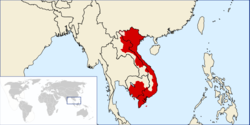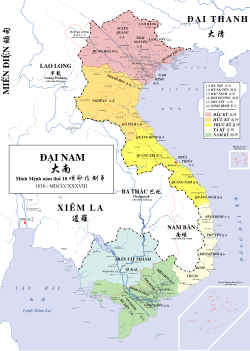User:Donald Trung/Nguyễn dynasty infobox proposals
Proposals for the infobox at the "Nguyễn dynasty" Wikipedia article.
Situation as the proposal started[edit]
Per this revision.
Đại Việt quốc 大越國 (1802–1804) (Đại) Việt Nam quốc (大)越南國 (1804–1839) Đại Nam quốc 大南國 (1839–1883) | |||||||||||||
|---|---|---|---|---|---|---|---|---|---|---|---|---|---|
| 1802–1883 | |||||||||||||
 Vietnam at its greatest territorial extent in 1840 (under Emperor Minh Mạng), superimposed on the modern political map | |||||||||||||
 Administrative divisions of Vietnam in 1838 (under Emperor Minh Mạng) | |||||||||||||
| Status | Internal imperial system within Chinese tributary[1] | ||||||||||||
| Capital | Huế 16°28′N 107°36′E / 16.467°N 107.600°E | ||||||||||||
| Common languages | Vietnamese Written Classical Chinese[2][3][a] | ||||||||||||
| Religion | Neo-Confucianism, Buddhism, Catholicism | ||||||||||||
| Government | Absolute monarchy | ||||||||||||
| Emperor | |||||||||||||
• 1802–1820 (first) | Gia Long | ||||||||||||
• 1883 (last independent) | Hiệp Hòa | ||||||||||||
• 1926–1945 (last) | Bảo Đại | ||||||||||||
| History | |||||||||||||
• Coronation of Gia Long | 1 June 1802 | ||||||||||||
| 1 September 1858 | |||||||||||||
| 5 June 1862 | |||||||||||||
| 25 August 1883 | |||||||||||||
| 6 June 1884 | |||||||||||||
| Area | |||||||||||||
| 1830 | 557,000 km2 (215,000 sq mi) | ||||||||||||
| Population | |||||||||||||
• 1830 | 10,500,000[citation needed] | ||||||||||||
• 1858 | 12,031,000[citation needed] | ||||||||||||
• 1890 | 14,752,000[citation needed] | ||||||||||||
| Currency | Văn (Sapèque), Tiền, and Lạng | ||||||||||||
| |||||||||||||
| Today part of | Vietnam Laos Cambodia China | ||||||||||||
- ^ Kang, David C. (2012). East Asia Before the West: Five Centuries of Trade and Tribute. Columbia University Press. pp. 101–102.
In 1802 the Nguyen dynasty was recognized with an imperial pardon and tributary status. [...] there was no doubt in anyone's mind that China was the superior and the tributary state the inferior. The Vietnamese kings clearly realized that they had to acknowledge China's suzerainty and become tributaries [...]
- ^ Holcombe, Charles (2017). A History of East Asia. Cambridge University Press. p. 207. ISBN 9781107118737.
- ^ Kiernan, Ben (2017). Việt Nam: A History from Earliest Times to the Present. Oxford University Press. ISBN 9780195160765.
[Gia Long] also restored Chinese to its status as Việt Nam's official language of state [...] Until 1815 just as many Nguyễn court memorials were written in nôm as in classical Chinese.
Proposal 1[edit]
Đại Việt quốc 大越國 (1802–1804) (Đại) Việt Nam quốc (大)越南國 (1804–1839) Đại Nam quốc 大南國 (1839–1883) | |||||||||||||
|---|---|---|---|---|---|---|---|---|---|---|---|---|---|
| 1802–1883 | |||||||||||||
 Vietnam at its greatest territorial extent in 1840 (under Emperor Minh Mạng), superimposed on the modern political map | |||||||||||||
 Administrative divisions of Vietnam in 1838 (under Emperor Minh Mạng) | |||||||||||||
| Status | Internal imperial system within Chinese tributary[1] | ||||||||||||
| Capital | Huế 16°28′N 107°36′E / 16.467°N 107.600°E | ||||||||||||
| Common languages | Vietnamese Written Classical Chinese[2][3][a] | ||||||||||||
| Religion | Neo-Confucianism, Buddhism, Catholicism | ||||||||||||
| Government | Absolute monarchy | ||||||||||||
| Emperor | |||||||||||||
• 1802–1820 (first) | Gia Long | ||||||||||||
• 1883 (last independent) | Hiệp Hòa | ||||||||||||
• 1926–1945 (last) | Bảo Đại | ||||||||||||
| History | |||||||||||||
• Coronation of Gia Long | 1 June 1802 | ||||||||||||
| 1 September 1858 | |||||||||||||
| 5 June 1862 | |||||||||||||
| 25 August 1883 | |||||||||||||
| 6 June 1884 | |||||||||||||
| Area | |||||||||||||
| 1830 | 557,000 km2 (215,000 sq mi) | ||||||||||||
| Population | |||||||||||||
• 1830 | 10,500,000[citation needed] | ||||||||||||
• 1858 | 12,031,000[citation needed] | ||||||||||||
• 1890 | 14,752,000[citation needed] | ||||||||||||
| Currency | Zinc and copper-alloy cash coins (denominated in phần, văn, mạch, and quán) Silver and gold cash coins and ingots (denominated in phân, nghi, tiền, and lạng / lượng) | ||||||||||||
| |||||||||||||
| Today part of | Vietnam Laos Cambodia China | ||||||||||||
- ^ Kang, David C. (2012). East Asia Before the West: Five Centuries of Trade and Tribute. Columbia University Press. pp. 101–102.
In 1802 the Nguyen dynasty was recognized with an imperial pardon and tributary status. [...] there was no doubt in anyone's mind that China was the superior and the tributary state the inferior. The Vietnamese kings clearly realized that they had to acknowledge China's suzerainty and become tributaries [...]
- ^ Holcombe, Charles (2017). A History of East Asia. Cambridge University Press. p. 207. ISBN 9781107118737.
- ^ Kiernan, Ben (2017). Việt Nam: A History from Earliest Times to the Present. Oxford University Press. ISBN 9780195160765.
[Gia Long] also restored Chinese to its status as Việt Nam's official language of state [...] Until 1815 just as many Nguyễn court memorials were written in nôm as in classical Chinese.
Proposal 2[edit]
Đại Việt quốc 大越國 (1802–1804) (Đại) Việt Nam quốc (大)越南國 (1804–1839) Đại Nam quốc 大南國 (1839–1945) | |||||||||||||
|---|---|---|---|---|---|---|---|---|---|---|---|---|---|
| 1802–1882 (as a sovereign state) 1883–1945 (as a French protectorate) | |||||||||||||
 Vietnam at its greatest territorial extent in 1840 (under Emperor Minh Mạng), superimposed on the modern political map | |||||||||||||
 Administrative divisions of Vietnam in 1838 (under Emperor Minh Mạng) | |||||||||||||
| Status | Internal imperial system within Chinese tributary[1] | ||||||||||||
| Capital | Huế 16°28′N 107°36′E / 16.467°N 107.600°E | ||||||||||||
| Common languages | Vietnamese Written Classical Chinese[2][3][a] | ||||||||||||
| Religion | Neo-Confucianism, Buddhism, Catholicism | ||||||||||||
| Government | Absolute monarchy | ||||||||||||
| Emperor | |||||||||||||
• 1802–1820 (first) | Gia Long | ||||||||||||
• 1883 (last independent) | Hiệp Hòa | ||||||||||||
• 1926–1945 (last) | Bảo Đại | ||||||||||||
| History | |||||||||||||
• Coronation of Gia Long | 1 June 1802 | ||||||||||||
| 1 September 1858 | |||||||||||||
| 5 June 1862 | |||||||||||||
| 25 August 1883 | |||||||||||||
| 6 June 1884 | |||||||||||||
| Area | |||||||||||||
| 1830 | 557,000 km2 (215,000 sq mi) | ||||||||||||
| Population | |||||||||||||
• 1830 | 10,500,000[citation needed] | ||||||||||||
• 1858 | 12,031,000[citation needed] | ||||||||||||
• 1890 | 14,752,000[citation needed] | ||||||||||||
| Currency | Zinc and copper-alloy cash coins (denominated in phần, văn, mạch, and quán) Silver and gold cash coins and ingots (denominated in phân, nghi, tiền, and lạng / lượng) | ||||||||||||
| |||||||||||||
| Today part of | Vietnam Laos Cambodia China | ||||||||||||
- ^ Kang, David C. (2012). East Asia Before the West: Five Centuries of Trade and Tribute. Columbia University Press. pp. 101–102.
In 1802 the Nguyen dynasty was recognized with an imperial pardon and tributary status. [...] there was no doubt in anyone's mind that China was the superior and the tributary state the inferior. The Vietnamese kings clearly realized that they had to acknowledge China's suzerainty and become tributaries [...]
- ^ Holcombe, Charles (2017). A History of East Asia. Cambridge University Press. p. 207. ISBN 9781107118737.
- ^ Kiernan, Ben (2017). Việt Nam: A History from Earliest Times to the Present. Oxford University Press. ISBN 9780195160765.
[Gia Long] also restored Chinese to its status as Việt Nam's official language of state [...] Until 1815 just as many Nguyễn court memorials were written in nôm as in classical Chinese.
Proposal 3[edit]
Đại Việt quốc 大越國 (1802–1804) (Đại) Việt Nam quốc (大)越南國 (1804–1839) Đại Nam quốc 大南國 (1839–1945) Đế quốc Việt Nam 帝國越南 (1945) | |||||||||||||
|---|---|---|---|---|---|---|---|---|---|---|---|---|---|
| 1802–1882 (as a sovereign state) 1883–1945 (as a French protectorate) | |||||||||||||
 Vietnam at its greatest territorial extent in 1840 (under Emperor Minh Mạng), superimposed on the modern political map | |||||||||||||
 Administrative divisions of Vietnam in 1838 (under Emperor Minh Mạng) | |||||||||||||
| Status | Internal imperial system within Chinese tributary[1] | ||||||||||||
| Capital | Huế 16°28′N 107°36′E / 16.467°N 107.600°E | ||||||||||||
| Common languages | Vietnamese Written Classical Chinese[2][3][a] | ||||||||||||
| Religion | Neo-Confucianism, Buddhism, Catholicism | ||||||||||||
| Government | Absolute monarchy | ||||||||||||
| Emperor | |||||||||||||
• 1802–1820 (first) | Gia Long | ||||||||||||
• 1883 (last independent) | Hiệp Hòa | ||||||||||||
• 1926–1945 (last) | Bảo Đại | ||||||||||||
| History | |||||||||||||
• Coronation of Gia Long | 1 June 1802 | ||||||||||||
| 1 September 1858 | |||||||||||||
| 5 June 1862 | |||||||||||||
| 25 August 1883 | |||||||||||||
| 6 June 1884 | |||||||||||||
| Area | |||||||||||||
| 1830 | 557,000 km2 (215,000 sq mi) | ||||||||||||
| Population | |||||||||||||
• 1830 | 10,500,000[citation needed] | ||||||||||||
• 1858 | 12,031,000[citation needed] | ||||||||||||
• 1890 | 14,752,000[citation needed] | ||||||||||||
| Currency | Zinc and copper-alloy cash coins (denominated in phần, văn, mạch, and quán) Silver and gold cash coins and ingots (denominated in phân, nghi, tiền, and lạng / lượng) | ||||||||||||
| |||||||||||||
| Today part of | Vietnam Laos Cambodia China | ||||||||||||
- ^ Kang, David C. (2012). East Asia Before the West: Five Centuries of Trade and Tribute. Columbia University Press. pp. 101–102.
In 1802 the Nguyen dynasty was recognized with an imperial pardon and tributary status. [...] there was no doubt in anyone's mind that China was the superior and the tributary state the inferior. The Vietnamese kings clearly realized that they had to acknowledge China's suzerainty and become tributaries [...]
- ^ Holcombe, Charles (2017). A History of East Asia. Cambridge University Press. p. 207. ISBN 9781107118737.
- ^ Kiernan, Ben (2017). Việt Nam: A History from Earliest Times to the Present. Oxford University Press. ISBN 9780195160765.
[Gia Long] also restored Chinese to its status as Việt Nam's official language of state [...] Until 1815 just as many Nguyễn court memorials were written in nôm as in classical Chinese.
